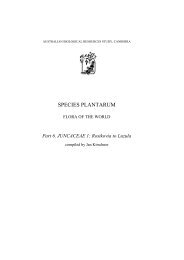Part 7. JUNCACEAE 2: Juncus - Species Plantarum Programme
Part 7. JUNCACEAE 2: Juncus - Species Plantarum Programme
Part 7. JUNCACEAE 2: Juncus - Species Plantarum Programme
You also want an ePaper? Increase the reach of your titles
YUMPU automatically turns print PDFs into web optimized ePapers that Google loves.
22<br />
SPECIES PLANTARUM — FLORA OF THE WORLD (2002)<br />
Coastal areas and rarely at inland saline sites of SW, SE and S Australia: Northern Territory,<br />
South Australia, Queensland, Tasmania, Victoria, Western Australia; and both main islands<br />
and Chatham Island of New Zealand. 50: NSW, NTA, QLD, SOA, TAS, VIC, WAU.<br />
51: NZN, NZS, CTM. Salt marshes, mangrove swamps, coastal sands, river banks, rarely<br />
lake shores. Map 183.<br />
50. NEW SOUTH WALES: Eden, E.F.Constable 53937 (K, W). NORTHERN TERRITORY: 32 km E of<br />
Kings Canyon, George Gill Range, A.C.Beauglehole 20515 (NSW, MEL). QUEENSLAND: Bribie Is,<br />
M.S.Clemens s.n. (RSA). SOUTH AUSTRALIA: c. 2 km N of Struan on Naracoorte road, K.L.Wilson 1220<br />
& L.A.S.Johnson (NSW). TASMANIA: Gordon Point, R.Melville 2440 (K). VICTORIA: Point Lonsdale,<br />
J.E.Tilden 716 (E, K). WESTERN AUSTRALIA: Leschenault Estuary, K.H.Rechinger 59716 (W).<br />
51. NORTH IS: Wellington, Walker 5189 (UC). SOUTH IS: South Is., NW of Nelson, estuary of Motuere<br />
R., W.R.Barker, B.V.Sneddon & E.Vitek 51-2 (W). CHATHAM IS.: Chatham Is., H.H.Travers (K).<br />
7c. <strong>Juncus</strong> kraussii subsp. austerus (Buchenau) Snogerup, Willdenowia 23: 63 (1993)<br />
<strong>Juncus</strong> austerus Buchenau, Junc. S.-Amer. 389 (1879) T: Chile, San Carlo, W.Lechler 3089; lecto: K, fide<br />
S.Snogerup, Willdenowia 23: 63 (1993).<br />
Illustration: S.Snogerup, Willdenowia 23: 64, fig. 19 (1993).<br />
Map: S.Snogerup, Willdenowia 23: 65, fig. 20 (1993).<br />
Intravaginal shoots absent. Cataphylls 3–5, pale brown, with uppermost 2–10 cm long, sometimes<br />
with a short lamina. Lower bract (3–) 9–20 (–60) cm long, including a sheath 2–6 cm long.<br />
Inflorescence (3–) 8–12 × (1.5–) 3.5–5 cm, usually ±dense, with flowers in (15–) 75–200 (–c. 1000)<br />
heads. Heads (1–) 3–8 (–10)-flowered. Tepals 2.5–3.5 mm long. Stamens 6 (rarely 3), c. 2/3 as<br />
long as tepals; anthers rarely well preserved in fruiting flowers, 0.8–1.7 mm long, 1.5–3 times<br />
as long as filaments; style 0.2–0.5 mm long; stigmas 1–1.5 mm long. Capsule 2.5–3 mm long,<br />
about equalling tepals, trigono-ellipsoidal to trigono-obovoid, obtuse to acute, light brown to<br />
glossy castaneous, trilocular; mucro up to 0.3 mm long; seeds usually 20–25. Seeds 0.7–0.9 mm<br />
long, or 0.8–1.2 mm long including appendages, 0.3–0.4 mm broad, ellipsoidal to obliquely<br />
ovoidal, dark brown, c. 25-striate; appendages small, unequal. Fig. 46.<br />
Restricted to temperate South America. 84: BZL, BZS. 85: AGS, CLS, URU. Probably only<br />
on coastal habitats, often maritime sands. Map 184.<br />
84. BRAZIL SOUTHEAST: São Paulo, Santos, 10 Jan 1875, C.W.H.Mosén 3502 p.p. (LD, O, S); São Paulo,<br />
Santos, S. Vincente, 10 Feb 1875, C.W.H.Mosén 3502 p.p. (S). BRAZIL SOUTH: Santa Catarina,<br />
[J.D.Hooker] (K). 85. ARGENTINA SOUTH: ‘Coast of Patagonia’, Oct 1832, C.Darwin (K). CHILE<br />
SOUTH: Llanquihue, Maullín, 28 Jan 1944, E.Barros 3076 (SI); Chile, Corral, W.Lechler 3089 (K).<br />
URUGUAY: Montevideo, Carrasco, C.Osten 21788b (S).<br />
8. <strong>Juncus</strong> roemerianus Scheele, Linnaea 22: 348 (1849)<br />
T: [USA, Texas] 'Galveston island auf feuchtem Muschelsand', 4 Apr 1846, Römer; holo: B, destroyed.<br />
Illustrations: S.Snogerup, Willdenowia 23: 66, fig. 21 (1993); R.E.Brooks & S.E.Clemants, Fl. N. Amer. 22:<br />
236 (2000)<br />
Map: S.Snogerup, Willdenowia 23: 68, fig. 22 (1993); R.E.Brooks & S.E.Clemants, Fl. N. Amer. 22: 238 (2000).<br />
Perennials, (15–) 50–150 (–230) cm long; rhizome creeping, stout, with internodes usually<br />
short; intravaginal shoots absent. Cataphylls 2–5, to 10 cm long; blade tiny. Leaves 40–125 cm<br />
long, 1.5–4 mm in diam. Lower bract (2–) 5–20 (–90) cm long, including a sheath 1.5–3 (–5) cm<br />
long; middle bracts small, amplexicaul, with blade ±absent; bracts subtending heads<br />
considerably shorter than flowers. Plant gynodioecious, with female and ±hermaphrodite<br />
clones. Inflorescence (2–) 5–20 (–45) × 3–6 (–12) cm, usually lax, ±broad; heads<br />
(15–) 30–100 (–200), 2–8 (–25)-flowered. Tepals 2.2–3.5 mm long, subequal, with margins<br />
scarious; outer tepals ±narrowly ovate, with base keeled, distally scarious margins slightly<br />
broader and mucro up to 0.3 mm long; inner tepals oblong, obtuse, with scarious part broad<br />
near apex. Stamens 6, equalling tepals or slightly shorter, rudimentary in pistillate flowers;












